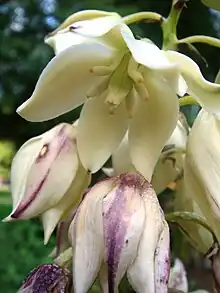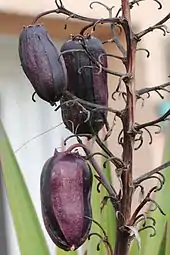Yucca aloifolia
Yucca aloifolia[4] is the type species for the genus Yucca. Common names include aloe yucca,[5] dagger plant,[6] and Spanish bayonet. It grows in sandy soils, especially on sand dunes along the coast.
| Spanish bayonet | |
|---|---|
 | |
| Yucca aloifolia, cultivated, Arizona State University, Tempe, Arizona | |
| Scientific classification | |
| Kingdom: | Plantae |
| Clade: | Tracheophytes |
| Clade: | Angiosperms |
| Clade: | Monocots |
| Order: | Asparagales |
| Family: | Asparagaceae |
| Subfamily: | Agavoideae |
| Genus: | Yucca |
| Species: | Y. aloifolia |
| Binomial name | |
| Yucca aloifolia | |
| Synonyms[2][3] | |
| |
Range
Yucca aloifolia is native to the Atlantic and Gulf Coasts of the United States from southern Virginia south to Florida and west to the Texas Gulf Coast, to Mexico along the Yucatán coast, and to Bermuda, and parts of the Caribbean. Normally Yucca aloifolia is grown in USDA zones 8 through 11. Yucca aloifolia is a popular landscape plant in beach areas along the lower East Coast from Virginia to Florida.
Yucca aloifolia has become naturalized in Bahamas, Argentina, Uruguay, Italy, Pakistan, South Africa, Queensland, New South Wales, and Mauritania. It is common in gardens and parks of the Iberian Peninsula (Portugal and Spain).[7]
Description
Yucca aloifolia has an erect trunk, 3–5 in (7.6–12.7 cm) in diameter, reaching up to 5–20 ft (1.5–6.1 m) tall before it becomes top heavy and topples over. When this occurs, the tip turns upward and keeps on growing. The trunk is armed with sharp pointed straplike leaves with fine-toothed edges, each about 2 ft (0.61 m) long. The young leaves near the growing tip stand erect; older ones are reflexed downward, and the oldest wither and turn brown, hanging around the lower trunk like a Hawaiian skirt. Eventually the tip of the trunk develops a 2 ft (0.61 m) long spike of white, purplish-tinged flowers, each blossom about 4 in (12.7 cm) across. After flowering, the trunk stops growing, but one or more lateral buds are soon formed, and the uppermost becomes a new terminal shoot. Yucca aloifolia also produces new buds, or offshoots, near the base of the trunk, forming the typical thicket often observed in dry sandy and scrub beach areas of the southeastern United States.[6][8][9][10][11][12]
Yucca aloifolia flowers are white and showy, sometimes tinged purplish, so that the plant is popular as an ornamental. Fruits are elongated, fleshy, up to 5 cm long. It is widely planted in hot climates and arid environments.[6][13][14][15][16][17]
Uses
The fruit is eaten by both birds and humans, and the flowers can be eaten cooked or raw.[18]
Yucca aloifolia's roots can be used as soap and shampoo.[19]
Gallery
 Yucca aloifolia at the San Francisco Botanical Garden
Yucca aloifolia at the San Francisco Botanical Garden Yucca aloifolia purplish fruits
Yucca aloifolia purplish fruits
References
- Solano, E.; Puente, R.; Ayala-Hernández, M.M.; Hodgson, W.; Clary, K.; Salywon, A. (2021). "Yucca aloifolia". IUCN Red List of Threatened Species. 2021: e.T117422548A117469927. doi:10.2305/IUCN.UK.2021-1.RLTS.T117422548A117469927.en. Retrieved 19 November 2021.
- Tropicos
- The Plant List
- Linnaeus, Species Plantarum 1: 319. 1753.
- USDA, NRCS (n.d.). "Yucca aloifolia". The PLANTS Database (plants.usda.gov). Greensboro, North Carolina: National Plant Data Team. Retrieved 8 August 2015.
- Flora of North America vol. 26, p. 429. 2006.
- López, Ginés (2007). Guía de los árboles y arbustos de la Península Ibérica y Baleares, 3rd edition (in Spanish).
- CONABIO. 2009. Catálogo taxonómico de especies de México. 1. In Capital Nat. México. CONABIO, Mexico City.
- ORSTOM. 1988. List of Vascular Plants of Gabon with Synonymy, Herbier National du Gabon, Yaounde
- Nanwal, H, M Hameed, T Nawaz, MSA Ahmad, A Younis. 2012. Structural adaptations for adaptability in some exotic and naturalized species of Agavaceae. Pakistani Journal of Botany 44 (special issue):129.134.
- Kew World Checklist of Selected Plant Families, Yucca aloifolia
- Altervista Flora Italiana, Jucca
- Davidse, G., M. Sousa Sánchez & A.O. Chater. 1994. Alismataceae a Cyperaceae. 6: i–xvi, 1–543. In G. Davidse, M. Sousa Sánchez & A.O. Chater (eds.) Flora Mesoamericana. Universidad Nacional Autónoma de México, México, D. F.
- Whalen, E.E. 1902. Killarney Gardening Newsletter 14(May):19-23
- Wunderlin, R. P. 1998. Guide to the Vascular Plants of Florida i–x, 1–806. University Press of Florida, Gainesville.
- Radford, A. E., H. E. Ahles & C. R. Bell. 1968. Manual of the Vascular Flora of the Carolinas i–lxi, 1–1183. University of North Carolina Press, Chapel Hill.
- Long, R. W. & O. K. Lakela. 1971. Flora of Tropical Florida: A Manual of the Seed Plants and Ferns of Southern Peninsular Florida i–xvii, 1–962. University of Miami Press, Coral Cables
- Little, Elbert L. (1980). The Audubon Society Field Guide to North American Trees: Eastern Region. New York: Knopf. p. 317. ISBN 0-394-50760-6.
- "Useful Plants | Practical Survivor".
External links
- Plants for a Future
- Floridata, Tallahassee Florida USA
- University of Florida IFAS Extension
- Lady Bird Johnson Wildflower Center, University of Texas
- Dave's Garden
- US Department of Agriculture Plants Profile
- How to Kill a Yucca Aloifolia by Melissa Lewis, Demand Media, SFGate, San Francisco California USA
- Plants of Upper Newport Bay (Newport Beach California USA), University of California at Irvine Natural History Society, Yucca aloifolia Liliaceae
- Royal Horticultural Society, London UK
- Wild Edible and Medicinal Plants, Keys to Liberty
- Atlas of Florida Vascular Plants, Institute for Systematic Biology, University of South Florida
- Horticulture Unlimited, Tucson Arizona USA, Spanish Bayonet
- Agraria, Piate de Vaso, Yucca, Tronchetto della felicità
